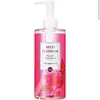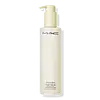What's inside
What's inside
 Key Ingredients
Key Ingredients

 Benefits
Benefits

 Concerns
Concerns

 Ingredients Side-by-side
Ingredients Side-by-side

Caprylic/Capric Triglyceride
MaskingOlea Europaea Fruit Oil
MaskingSorbeth-30 Tetraoleate
EmulsifyingWater
Skin ConditioningPEG-8 Diisostearate
EmulsifyingHexyldecyl Myristoyl Methylaminopropionate
EmollientButylene Glycol
HumectantCamellia Japonica Seed Oil
EmollientSophora Japonica Flower Extract
Skin ProtectingPaeonia Suffruticosa Root Extract
Skin ProtectingScutellaria Baicalensis Root Extract
AstringentTocopheryl Acetate
AntioxidantCaprylyl Glycol
EmollientCaprylhydroxamic Acid
Glycerin
HumectantParfum
MaskingCaprylic/Capric Triglyceride, Olea Europaea Fruit Oil, Sorbeth-30 Tetraoleate, Water, PEG-8 Diisostearate, Hexyldecyl Myristoyl Methylaminopropionate, Butylene Glycol, Camellia Japonica Seed Oil, Sophora Japonica Flower Extract, Paeonia Suffruticosa Root Extract, Scutellaria Baicalensis Root Extract, Tocopheryl Acetate, Caprylyl Glycol, Caprylhydroxamic Acid, Glycerin, Parfum
Isopropyl Palmitate
EmollientCaprylic/Capric Triglyceride
MaskingPEG-20 Glyceryl Triisostearate
EmollientIsohexadecane
EmollientPentaerythrityl Tetraethylhexanoate
EmollientPEG-8 Diisostearate
EmulsifyingCoco-Caprylate/Caprate
EmollientTriisostearin
Skin ConditioningPEG-12 Diisostearate
EmulsifyingPaeonia Albiflora Flower Extract
TonicCamellia Japonica Seed Oil
EmollientSimmondsia Chinensis Seed Oil
EmollientLimnanthes Alba Seed Oil
Skin ConditioningHelianthus Annuus Seed Oil
EmollientZea Mays Oil
EmulsifyingWater
Skin ConditioningCaprylyl Glycol
EmollientButylene Glycol
HumectantPolyglyceryl-2 Triisostearate
EmulsifyingHexylene Glycol
EmulsifyingDipentaerythrityl Tri-Polyhydroxystearate
EmollientParfum
MaskingTocopheryl Acetate
AntioxidantPhenoxyethanol
PreservativeIsopropyl Palmitate, Caprylic/Capric Triglyceride, PEG-20 Glyceryl Triisostearate, Isohexadecane, Pentaerythrityl Tetraethylhexanoate, PEG-8 Diisostearate, Coco-Caprylate/Caprate, Triisostearin, PEG-12 Diisostearate, Paeonia Albiflora Flower Extract, Camellia Japonica Seed Oil, Simmondsia Chinensis Seed Oil, Limnanthes Alba Seed Oil, Helianthus Annuus Seed Oil, Zea Mays Oil, Water, Caprylyl Glycol, Butylene Glycol, Polyglyceryl-2 Triisostearate, Hexylene Glycol, Dipentaerythrityl Tri-Polyhydroxystearate, Parfum, Tocopheryl Acetate, Phenoxyethanol
 Reviews
Reviews

Ingredients Explained
These ingredients are found in both products.
Ingredients higher up in an ingredient list are typically present in a larger amount.
Butylene Glycol (or BG) is used within cosmetic products for a few different reasons:
Overall, Butylene Glycol is a safe and well-rounded ingredient that works well with other ingredients.
Though this ingredient works well with most skin types, some people with sensitive skin may experience a reaction such as allergic rashes, closed comedones, or itchiness.
Learn more about Butylene GlycolCamellia Japonica Seed Oil comes from the Japanese Camellia plant. This plant is native to East Asia and known as "Tsubaki" in Japanese.
Camellia Japonica Seed Oil is rich in oleic acid. This makes it a great emollient. Emollients help soften and soothe the skin by forming a barrier. This barrier traps moisture within, keeping your skin hydated.
This ingredient is an emollient, solvent, and texture enhancer. It is considered a skin-softener by helping the skin prevent moisture loss.
It helps thicken a product's formula and makes it easier to spread by dissolving clumping compounds.
Caprylic Triglyceride is made by combining glycerin with coconut oil, forming a clear liquid.
While there is an assumption Caprylic Triglyceride can clog pores due to it being derived from coconut oil, there is no research supporting this.
Learn more about Caprylic/Capric TriglycerideCaprylyl Glycol is a humectant and emollient, meaning it attracts and preserves moisture.
It is a common ingredient in many products, especially those designed to hydrate skin. The primary benefits are retaining moisture, skin softening, and promoting a healthy skin barrier.
Though Caprylyl Glycol is an alcohol derived from fatty acids, it is not the kind that can dry out skin.
This ingredient is also used as a preservative to extend the life of products. It has slight antimicrobial properties.
Learn more about Caprylyl GlycolParfum is a catch-all term for an ingredient or more that is used to give a scent to products.
Also called "fragrance", this ingredient can be a blend of hundreds of chemicals or plant oils. This means every product with "fragrance" or "parfum" in the ingredients list is a different mixture.
For instance, Habanolide is a proprietary trade name for a specific aroma chemical. When used as a fragrance ingredient in cosmetics, most aroma chemicals fall under the broad labeling category of “FRAGRANCE” or “PARFUM” according to EU and US regulations.
The term 'parfum' or 'fragrance' is not regulated in many countries. In many cases, it is up to the brand to define this term.
For instance, many brands choose to label themselves as "fragrance-free" because they are not using synthetic fragrances. However, their products may still contain ingredients such as essential oils that are considered a fragrance by INCI standards.
One example is Calendula flower extract. Calendula is an essential oil that still imparts a scent or 'fragrance'.
Depending on the blend, the ingredients in the mixture can cause allergies and sensitivities on the skin. Some ingredients that are known EU allergens include linalool and citronellol.
Parfum can also be used to mask or cover an unpleasant scent.
The bottom line is: not all fragrances/parfum/ingredients are created equally. If you are worried about fragrances, we recommend taking a closer look at an ingredient. And of course, we always recommend speaking with a professional.
Learn more about ParfumPEG-8 Diisostearate isn't fungal acne safe.
Tocopheryl Acetate is AKA Vitamin E. It is an antioxidant and protects your skin from free radicals. Free radicals damage the skin by breaking down collagen.
One study found using Tocopheryl Acetate with Vitamin C decreased the number of sunburned cells.
Tocopheryl Acetate is commonly found in both skincare and dietary supplements.
Learn more about Tocopheryl AcetateWater. It's the most common cosmetic ingredient of all. You'll usually see it at the top of ingredient lists, meaning that it makes up the largest part of the product.
So why is it so popular? Water most often acts as a solvent - this means that it helps dissolve other ingredients into the formulation.
You'll also recognize water as that liquid we all need to stay alive. If you see this, drink a glass of water. Stay hydrated!
Learn more about Water